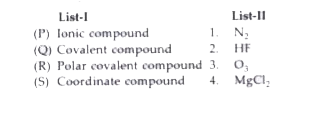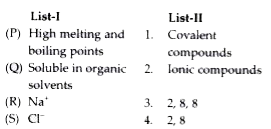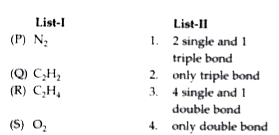Exercise (Assertion & Reason Type) from MTG IIT JEE FOUNDATION CHEMICAL BONDING for Class 10
| Class 10 | CHEMISTRY |
| Chapter | CHEMICAL BONDING |
| MTG IIT JEE FOUNDATION | Exercise (Assertion & Reason Type) |
| Medium | English |
| Academic Year | 2023-2024 |
Question 66
The compounds containing ionic bonds are known as ionic compounds. They are formed by the transfer of electrons from one atom to another. The ionic compounds are made up of positively charged ions (cations) and negatively charged ions (anions).
Ionic compounds are made up of View SolutionQuestion 67
The compounds containing ionic bonds are known as ionic compounds. They are formed by the transfer of electrons from one atom to another. The ionic compounds are made up of positively charged ions (cations) and negatively charged ions (anions).
Cations and anions present in sodium hydroxide areView SolutionQuestion 68
The compounds containing ionic bonds are known as ionic compounds. They are formed by the transfer of electrons from one atom to another. The ionic compounds are made up of positively charged ions (cations) and negatively charged ions (anions).
Which one of the following is an ionic compound? View SolutionQuestion 69
When a covalent bond is formed between two similar atoms, the shared pair of electrons is equally attracted by the two atoms. As a result of this, the electron pair is situated exactly in between two identical nuclei. The bond is known as non-polar covalent bond. On the other hand, if the atoms forming bonds are different, the electron attracting powers of the two atoms in a bond may differ. Consequently, the shared pair will be displaced towards the atom having more electronegativity.
Which one of the following is a polar covalent compound?View SolutionQuestion 70
When a covalent bond is formed between two similar atoms, the shared pair of electrons is equally attracted by the two atoms. As a result of this, the electron pair is situated exactly in between two identical nuclei. The bond is known as non-polar covalent bond. On the other hand, if the atoms forming bonds are different, the electron attracting powers of the two atoms in a bond may differ. Consequently, the shared pair will be displaced towards the atom having more electronegativity.
Which one of the following is a non-polar covalent compound? View SolutionQuestion 71
When a covalent bond is formed between two similar atoms, the shared pair of electrons is equally attracted by the two atoms. As a result of this, the electron pair is situated exactly in between two identical nuclei. The bond is known as non-polar covalent bond. On the other hand, if the atoms forming bonds are different, the electron attracting powers of the two atoms in a bond may differ. Consequently, the shared pair will be displaced towards the atom having more electronegativity.
Covalency of carbon in CO2 is View SolutionQuestion 72
Sidgwick proposed that an atom contributes both the electrons for mutual sharing and that electron pair is shared by the two atoms. Such a covalent bond is called coordinate covalent bond or dative bond. The atom or ion or molecule, which donates the electron pair, is called donor. The atom or ion or molecule, which accepts the electron pair, is called acceptor.
Molecule in which coordinate bond is present is View SolutionQuestion 73
Sidgwick proposed that an atom contributes both the electrons for mutual sharing and that electron pair is shared by the two atoms. Such a covalent bond is called coordinate covalent bond or dative bond. The atom or ion or molecule, which donates the electron pair, is called donor. The atom or ion or molecule, which accepts the electron pair, is called acceptor.
Coordinate bond is represented by arrow pointing from View SolutionQuestion 74
Sidgwick proposed that an atom contributes both the electrons for mutual sharing and that electron pair is shared by the two atoms. Such a covalent bond is called coordinate covalent bond or dative bond. The atom or ion or molecule, which donates the electron pair, is called donor. The atom or ion or molecule, which accepts the electron pair, is called acceptor.
The melting and boiling points of coordinate compound are ____ ionic compounds and covalent compound. View Solution




